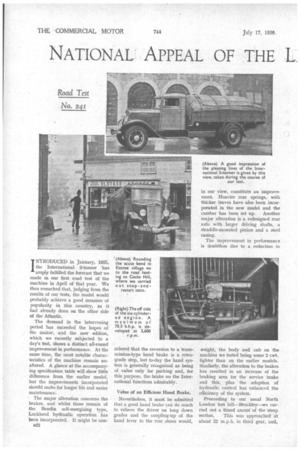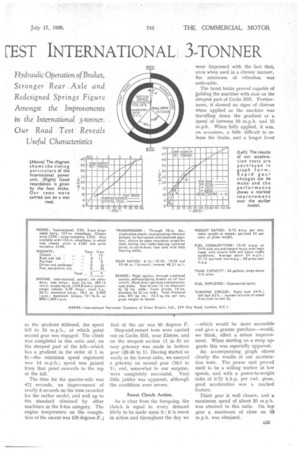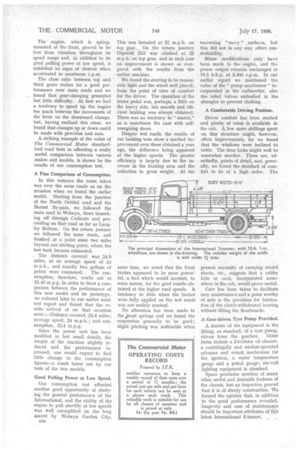NATIONAL APPEAL OF THE L
Page 32

Page 33

Page 34

If you've noticed an error in this article please click here to report it so we can fix it.
['EST INTERNATIONAL 3 TONNER
NTRODUCED in January, 1935, the International 3-tonner has
amply fulfilled the forecast that we made in our first road test of the machine in April of that year. We then remarked that, judging from the results of our tests, the model would probably achieve a good measure of popularity in this country, as it had already done on the other side of the Atlantic.
The demand in the intervening period has exceeded the hopes of the maker, and the new edition, which we recently subjected to a day's test, shows a distinct all-round improvement in performance. At the same time, the most notable characteristics of the machine remain unaltered. A glance at the accompanying specification table will show little difference from the earlier model, but the improvements incorporated should make for longer life and easier maintenance.
The major alteration concerns the brakes, and whilst these remain of the Bendix self-energizing type, Lockheed hydraulic operation has been incorporated. It might be con
• B22
sidered that the reversion to a transmission-type hand brake is a retrograde step, but to-day the hand system is generally recognized as being of value only for parking and, for this purpose, the brake on the International functions admirably.
Value of an Efficient Hand Brake.
Nevertheless, it must be admitted that a good hand brake can do much to relieve the driver on long down grades and the coupling-up of the hand lever to the rear shoes would, weight, the body and cab on the machine we tested being some 2 cwt. lighter than on the earlier models. Similarly, the alteration to the brakes has resulted in an increase of the braking area for the service brake and this, plus the adoption of hydraulic control has enhanced the efficiency of the system.
Proceeding to our usual North London test hill—Brockley—we carried out a timed ascent of the steep
section. This was apprOached at about 22 m.p.h. in third gear, and,
as the gradient stiffened, the speed fell to 18 m.p.h., at which point second gear was engaged. The climb was completed in this ratio and, on the steepest part of the hill-which has a gradient in the order of 1 in 8l,--the minimum speed registered was 14 m.p.h.; speed was gained from that point onwards to the top of the hill.
The time for the quarter-mile was 47! seconds, an improvement of nearly 8 seconds on the time recorded for the earlier model, and well up to the standard obtained by other machines in the 3-ton category. The engine temperature on the completion of the ascent was 150 degrees F. that of the air was 60 degrees F.
Stop-and-restart tests were carried out on Cocks Hill, near Elstree, and on the steepest section (1 in 6) an easy getaway was made in bottom gear (39.46 to 1). Having started so easily in the lowest ratio, we essayed a getaway on second gear (19.1 to 1), and, somewhat to our surprise, were completely successful. Very little judder was apparent, although the conditions were severe.
Sweet Clutch Action.
As is clear from the foregoing, the clutch is equal to every demand likely to be made upon it; it is sweet in action and throughout the day we -which would be more accessible and give a greater purchase-would, we think, effect a minor improvement. When starting on a steep upgrade this was especially apparent.
An accompanying graph shows clearly the results of our acceleration tests, The power unit proved itself to be a willing worker at low speeds, and with a power-to-weight ratio of 0.72 b.h.p. per cwt. gross, good acceleration was a marked feature.
Third gear is well chosen, and a maximum speed of about 35 m.p.h. was attained in this ratio. On. top gear a maximum of close on 50 m.p.h. was obtained.
The engine, which is springmounted at the front, proved to be free from vibration throughout its speed range and, in addition to its good pulling power at low speed, it exhibited no signs of distress when accelerated to maximum r.p.m.
The close ratio between top and third gears makes for a good performance over main roads and we found that gear-changing presented but little difficulty. At first we had a tendency to speed up the engine too much between the movements of the lever on the downward change, but, having realized this error, we found that changes up or down could be made with precision and ease.
A striking example of the value of The Commercial Motor standardized road tests in affording a really useful comparison between various makes and models, is shown by the results of our consumption test. •
A Fine Comparison of Consumption.
In this instance the route taken was over the same roads as on the occasion when we tested the earlier model. Starting from the junction of the North Orbital road and the Barnet By-pass, we followed the main road to Welwyn, there branching off through Codicote and proceeding on that road as far as Langley Bottom. On the return journey we followed the same route, and finished at a point some two miles beyond our starting point, where the test tank became exhausted.
_ The distance covered was 24.9 miles, at an average speed of 24 m.p.h., and exactly two gallons of petrol were consumed.. The consumption, therefore, works out at 12.45 m.p.g. In order to draw a. comparison between the performance of this new model and its prototype, we referred later to our earlier roadtest report and found that the results arrived at on that occasion were :—Distance covered, 24.8 miles ; average speed, 24 m.p.h. ; and consumption, 12.4 m.p.g.
Since the power unit has been modified in but small details, the weight of the machine slightly reduced and the performance increased, one would expect to find little change in the consumption figures—a result borne out by our tests of the two models.
Good Pulling Power at Low Speed. Our consumption test afforded another good opportunity of studying the general performance of the International, and the ability of the engine to pull sturdily at low speeds was well exemplified on the long ascent by 'Welwyn Garden City. This was breasted at 22 m.p.h. on top gear. On the return journey Digswell Hill was climbed at 23 m.p.h. on top gear, and in each case an improvement is shown as compared with the results from the earlier machine.
We found the steering to be reasonably light and the wheel well placed, from the point of view of comfort for the driver. The operation of the brake pedal was, perhaps, a little on the heavy side, but smooth and efficient braking was always obtained. There was no tendency to " snatch," as is sometimes the case with selfenergizing shoes.
Despite wet roads, the results of our braking tests show a marked improvement over those obtained a year ago, the difference being apparent at the higher speeds. The greater efficiency is largely due to the increase in the braking area and the reduction in gross weight. At the same time, we noted that the front brakes appeared to be more powerful, a fact which would account, to some extent, for the good results obtained at the higher road speeds. A tendency to slide when the brakes were fully applied on the wet roads was not unduly marked.
No alteration has been made to the ofront springs and we found the suspension generally to be good; slight pitching was noticeable when
traversing " wavy " surfaces, but this did not in any way affect controllability.
Minor modifications only have been made to the engine, and the power output remains unchanged at 78.5 b.h.p. at 3,400 r.p.na. In our earlier report we mentioned the value of the "pump accelerator" incorporated in the carburetter, also the relief valves embodied in the strangler to prevent choking.
A Comfortable Driving Position.
Driver comfort has been studied and plenty of room is available in the cab. A few more shillings spent on this structure might, however, effect improvements, for we found that the windows were inclined to rattle. The door locks might well be somewhat sturdier. These are, admittedly, points of detail, and, generally, we found the standard of comfort to be of a high order. The present necessity of carrying record sheets, etc., suggests that a cubby hole or rack, incorporated somewhere in the cab, would prove useful.
Care has been taken to facilitate easy maintenance and a point worthy of note is the provision for lubrication of the clutch-withdrawal bearing without lifting the floorboards.
A Gear-driven Tyre Pump Provided.
A feature of the equipment is the fitting, as standard, of a tyre pump, driven from the gearbox. Other items include a Purolator oil cleaner, a centrifugally and suction-operated advance and retard mechanism for the ignition, a water temperature gauge and a petrol gauge ; six-volt lighting equipment is standard. Space precludes mention of many other useful and desirable features of the chassis, but an inspection proved that it is of sturdy construction. We formed the opinion that, in addition to the good performance revealed, longevity and ease of maintenauee should be important attributes of this latest International 3-tonner.




















































































